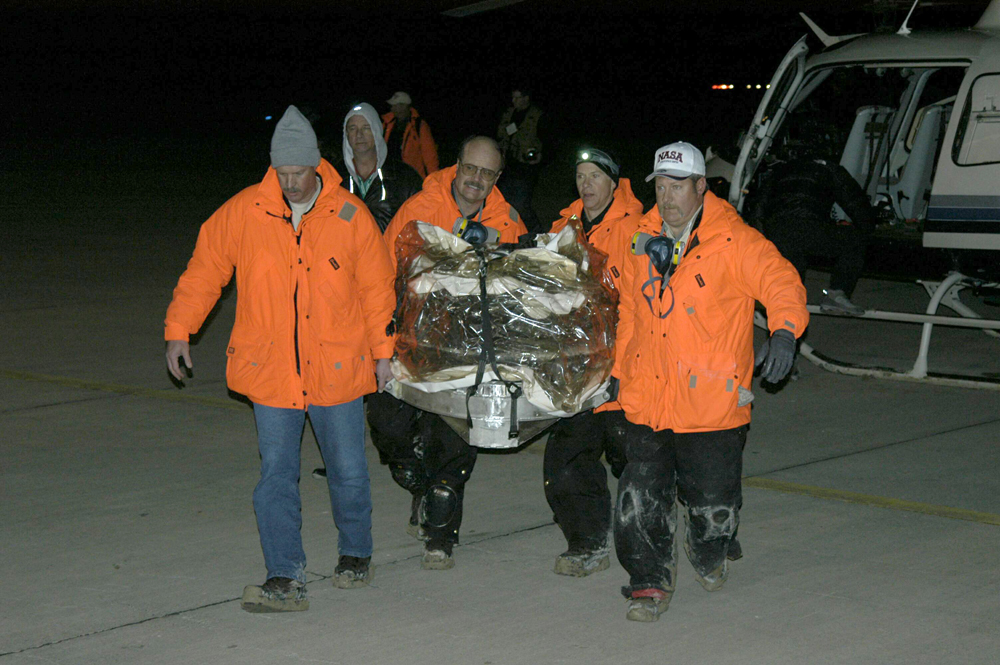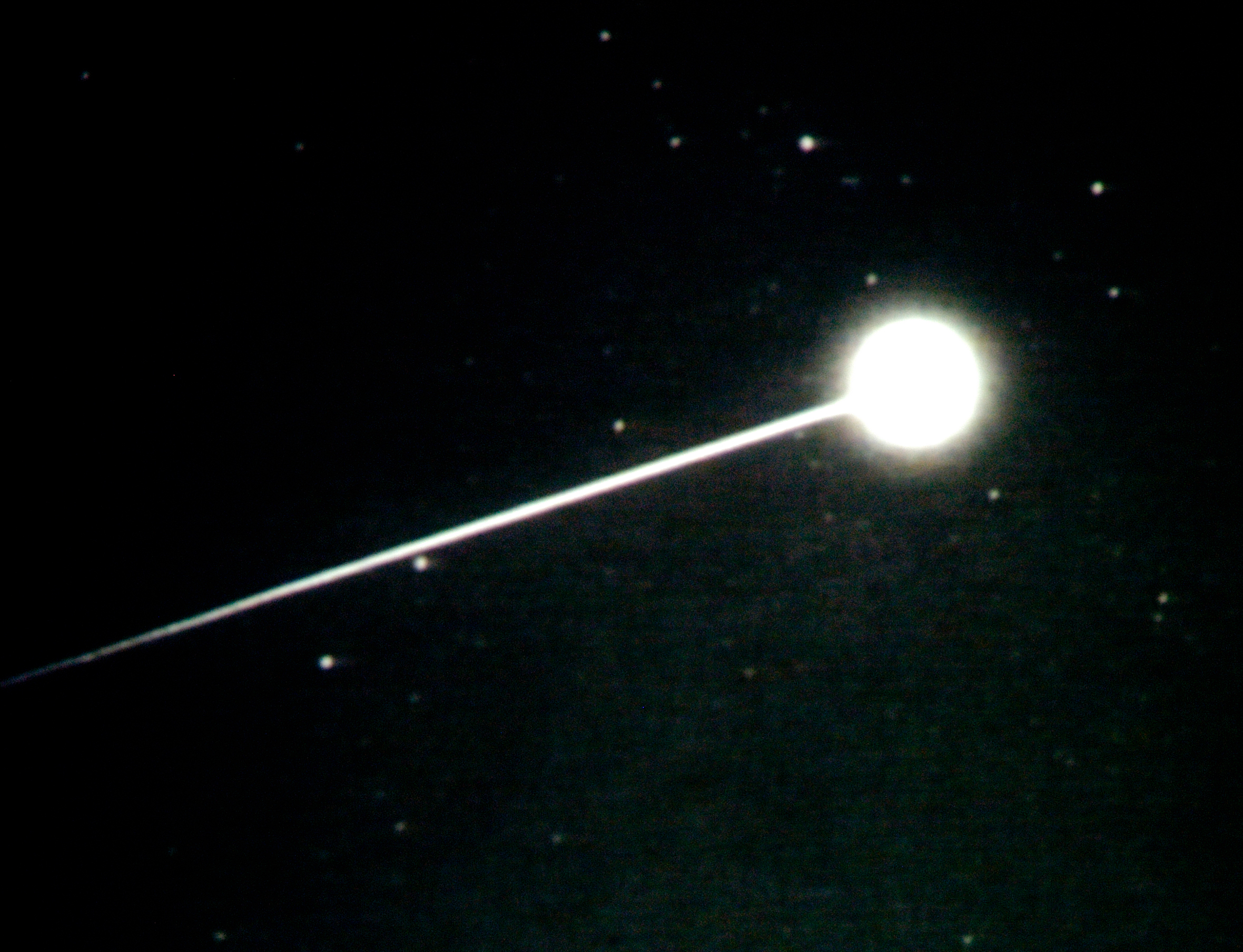Geotimes

Untitled Document

Web Extra
Tuesday, January 17, 2006
Stardust landing a smashing
success
 Seven years
after the launch of NASA's Stardust spacecraft, its return
capsule safely landed early Sunday in the Utah desert. The landing concludes
a 4.6-billion-kilometer roundtrip journey to fly through the tail of a comet
and collect dust samples, which astronomers hope will offer insight about the
formation of our solar system.
Seven years
after the launch of NASA's Stardust spacecraft, its return
capsule safely landed early Sunday in the Utah desert. The landing concludes
a 4.6-billion-kilometer roundtrip journey to fly through the tail of a comet
and collect dust samples, which astronomers hope will offer insight about the
formation of our solar system.
After the Stardust return capsule landed
early Sunday in Utah, a helicopter crew placed it inside a protective covering
and transported it via helicopter to a temporary clean room. Science team members
plan to study tiny grains inside the capsule, collected as it passed through
the tail of comet Wild 2. Images are courtesy of NASA/JPL.
The Stardust spacecraft approached Earth early Sunday and, prior to maneuvering
into orbit with the sun, released the return capsule and pushed it toward Earth.
Four hours later, the capsule cruised through the atmosphere at about 45,000
kilometers per hour — 70 percent faster than a space shuttle reentry and
the highest reentry speed of any human-made object ever — and produced
a large comet-like fireball that could be seen bolting across the sky from some
of the western United States.
"This thing lasted about half a minute, constantly getting brighter and
climbing in the sky. And then we started noticing there was a luminous trail,
this long trail behind it," said Don Brownlee, the Stardust mission principal
investigator, at an onsite news briefing broadcasted in a NASA podcast. "It's
ironic that you have a comet mission that ends producing a comet."
After touchdown occurred at the U.S. Air Force's Utah Test and Training Range,
helicopter crews picked up the capsule, flying it to a temporary clean room
at Michael Army Air Field, more than 100 kilometers west of Salt Lake City,
Utah, where it awaited transfer to Johnson Space Center in Houston, Texas. "I
kind of view this as we're on the 1-yard line," said Joe Vellinga, the
deputy recovery operations manager, in the post-landing NASA podcast. "The
real touchdown," Vellinga said, will be when the craft is opened and the
science team finds out how many particles were recovered. That could happen
anytime between Jan. 18 and Jan. 20, says Merrilee Fellows, a NASA representative.
In the meantime, according to a Jan.16 Associated Press report,
the craft appeared to be in "pristine" condition.
 The Stardust
science team hopes to find more than 1,000 dust grains embedded in the gel-like
substance within the capsule's collection grid, which resembles a large tennis
racket. Those particles collected from the tail of comet Wild 2, most of which
are smaller than a human hair, are the dusty remains of materials that scientists
think formed the sun and planets in our solar system about 4.5 billion years
ago.
The Stardust
science team hopes to find more than 1,000 dust grains embedded in the gel-like
substance within the capsule's collection grid, which resembles a large tennis
racket. Those particles collected from the tail of comet Wild 2, most of which
are smaller than a human hair, are the dusty remains of materials that scientists
think formed the sun and planets in our solar system about 4.5 billion years
ago.
The Stardust capsule entered Earth's atmosphere
with a streak of light, recorded here from NASA aircraft. Researchers will use
the images to study the conditions during the fastest-to-date reentry of a human-made
object.
Study of the grains' composition for the first time in a lab might help astronomers
figure out how elements came together to form the solar system. The team will
also look to see if the gel captured interstellar grains from distant star explosions,
which create numerous heavy elements that are necessary for life, such as carbon,
nitrogen and oxygen.
In other NASA firsts, the New Horizons spacecraft was
set to launch this afternoon aboard the Atlas V rocket, en route to Pluto (windy
weather conditions caused the delay of that launch, which was rescheduled for
Jan.18, according to a Jan. 17 NASA press release). The first spacecraft to
travel to the distant planet is part of a flyby mission planned to take a closer
look at what surface features lie beneath Pluto's dense orange atmosphere, and
to capture images of its moon Charon. Stay tuned, however, as the New Horizons
spacecraft is not planned to make its earliest Pluto-Charon flyby until July
2015.
Kathryn Hansen
Links:
Stardust:
NASA's comet sample return mission
New
Horizons: NASA's Pluto-Kuiper Belt mission
Associated
Press story
Back to top
Untitled Document

 Seven years
after the launch of NASA's Stardust spacecraft, its return
capsule safely landed early Sunday in the Utah desert. The landing concludes
a 4.6-billion-kilometer roundtrip journey to fly through the tail of a comet
and collect dust samples, which astronomers hope will offer insight about the
formation of our solar system.
Seven years
after the launch of NASA's Stardust spacecraft, its return
capsule safely landed early Sunday in the Utah desert. The landing concludes
a 4.6-billion-kilometer roundtrip journey to fly through the tail of a comet
and collect dust samples, which astronomers hope will offer insight about the
formation of our solar system. 
 The Stardust
science team hopes to find more than 1,000 dust grains embedded in the gel-like
substance within the capsule's collection grid, which resembles a large tennis
racket. Those particles collected from the tail of comet Wild 2, most of which
are smaller than a human hair, are the dusty remains of materials that scientists
think formed the sun and planets in our solar system about 4.5 billion years
ago.
The Stardust
science team hopes to find more than 1,000 dust grains embedded in the gel-like
substance within the capsule's collection grid, which resembles a large tennis
racket. Those particles collected from the tail of comet Wild 2, most of which
are smaller than a human hair, are the dusty remains of materials that scientists
think formed the sun and planets in our solar system about 4.5 billion years
ago. 